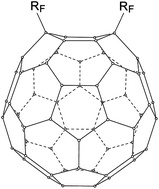A series of seven structurally-similar compounds with different pairs of RF groups were prepared, characterized spectroscopically, and studied by electrochemical methods (cyclic and square-wave voltammetry), low-temperature anion photoelectron spectroscopy, and DFT calculations (five of the compounds are reported here for the first time). This is the first time that a set of seven RF groups have been compared with respect to their relative effects on E1/2(0/−), electron affinity (EA), and the DFT-calculated LUMO energy. The compounds, 1,7-C60(RF)2 (RF = CF3, C2F5, i-C3F7, n-C3F7, s-C4F9, n-C4F9 and n-C8F21), were found to have statistically different electron affinities (EA), at the ±10 meV level of uncertainty, but virtually identical first reduction potentials, at the ±10 mV level of uncertainty. The lack of a correlation between EA and E1/2(0/−), and between E(LUMO) and E1/2(0/−), for such similar compounds is unprecedented and suggests that explanations for differences in figures of merit for materials and/or devices that are based on equating easily measurable E1/2(0/−) values with EAs or E(LUMO) values should be viewed with caution. The solubilities of the seven compounds in toluene varied by nearly a factor of six, but in an unpredictable way, with the C2F5 and s-C4F9 compounds being the most soluble and the i-C3F7 compound being the least soluble. The effects of the different RF groups on EAs, E(LUMO) values, and solubilities should help fluorine chemists choose the right RF group to design new materials with improved morphological, electronic, optical, and/or magnetic properties.


 Please wait while we load your content...
Please wait while we load your content...